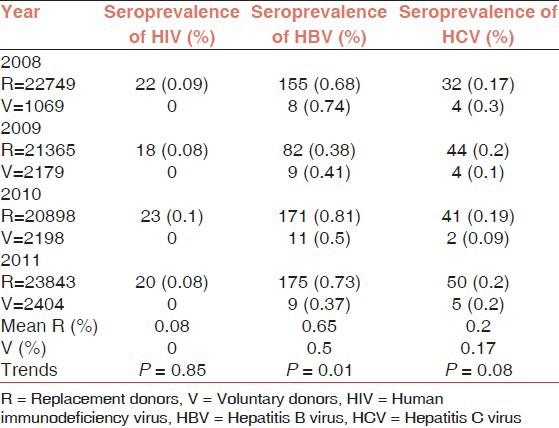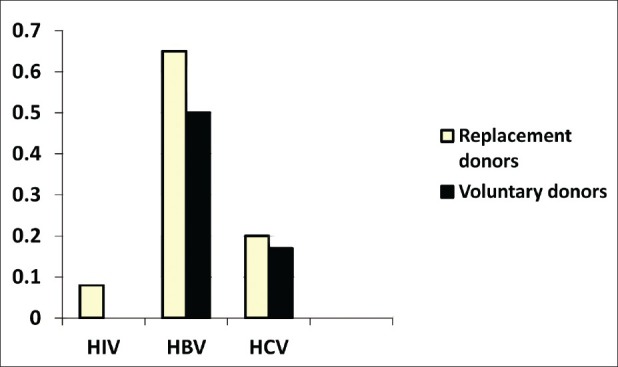Sir,
In the present cross-sectional study, we reviewed 96,705 healthy blood donors over a period of 4 years from January 2008 to December 2011 from the records of Department of Transfusion Medicine, Government Medical College and Associated Shri Maharaja Gulab Singh Hospital Jammu [Table 1]. The study analyzed the seroprevalence of three major markers for transfusion transmitted infections (TTIs) that are human immunodeficiency virus (HIV), hepatitis B virus (HBV) and hepatitis C virus (HCV) and trends of these TTIs in voluntary and replacement blood donors of Jammu province by using third generation enzyme linked immuno sorbent assay kits.
Table 1.
Showing 4 years seroprevalance and trends of human immunodeficiency virus, hepatitis B virus and hepatitis C virus

Out of total donations, 91.9% (88,855) were replacement donations and 8.1% (7850) were voluntary donors. There was 55.5% increase in voluntary donation from 1064 in 2008 to 2404 in 2011 as compared with only 13% increase in replacement donors from 22,749 in 2008 to 23,843 in 2011. Figure 1 shows mean seroprevalence of HIV 0.08% in replacement and nil in voluntary, HBV 0.65% and 0.5% and HCV 0.2% and 0.17% in replacement and voluntary donors, respectively of Jammu province.
Figure 1.

Seroprevalence of human immunodeficiency virus, hepatitis B virus and hepatitis C virus
The present study was dominated by replacement donors similar to other studies reporting, 99.48%,[1] 82%,[2] and 94.7%[3] from Northern India. Jammu and Kashmir falls in low prevalence area on HIV map of India with prevalence of 0.09% in young adults. Our study showed much lower seroprevalence of HIV similar to Gupta et al.[4] who reported 0.08%. Other studies showed higher prevalence 0.56%,[1] 0.8%,[2] and 0.45% in replacement donors and 0.32% in voluntary donors,[5] 0.44% and 0.15% in replacement and voluntary donor, respectively in Chandigarh.[6]
Seroprevalence of HBV in the present study is in accordance with Gupta et al.[4] who reported seropositivity of 0.66%. Kaur et al.[6] reported 1.07% and 0.65% in replacement and voluntary donors; Pahuja et al.[1] reported much higher prevalence of 2.23%. Increasing trends of HBV infection was seen in replacement donors which may be due to fact that replacement donors conceal information about their health during donor selection to get the blood for their patient, thus compromising blood safety.
Seroprevalence of HCV in present study was similar to Gupta et al. from Punjab reported 0.11%;[4] Kaur et al.[6] reported 0.5% and 0.3%, Sharma et al.[1] reported 0.52% and 0.23% in replacement and voluntary donor, respectively.
To conclude, seropositivity for TTIs in present study was slightly lower than that reported in other studies. This may be due to as per National AIDS Control Organization low prevalence of HIV and hepatitis in our population.[7] Voluntary donors were found to be safer than replacement donors. Better donor motivation, recruitment and retention strategies along with public awareness through multisectoral involvement of voluntary blood donation organization, blood bank personnel’s, government and non-government agencies and media to improve voluntary donation should be implemented to increase the blood safety.
References
- 1.Pahuja S, Sharma M, Baitha B, Jain M. Prevalence and trends of markers of hepatitis C virus, hepatitis B virus and human immunodeficiency virus in Delhi blood donors: A hospital based study. Jpn J Infect Dis. 2007;60:389–91. [PubMed] [Google Scholar]
- 2.Singh B, Kataria SP, Gupta R. Infectious markers in blood donors of East Delhi: Prevalence and trends. Indian J Pathol Microbiol. 2004;47:477–9. [PubMed] [Google Scholar]
- 3.Kakkar N, Kaur R, Dhanoa J. Voluntary donors-need for a second look. Indian J Pathol Microbiol. 2004;47:381–3. [PubMed] [Google Scholar]
- 4.Gupta N, Kumar V, Kaur A. Seroprevalence of HIV, HBV, HCV and syphilis in voluntary blood donors. Indian J Med Sci. 2004;58:255–7. [PubMed] [Google Scholar]
- 5.Sharma RR, Cheema R, Vajpayee M, Rao U, Kumar S, Marwaha N, et al. Prevalence of markers of transfusion transmissible diseases in voluntary and replacement blood donors. Natl Med J India. 2004;17:19–21. [PubMed] [Google Scholar]
- 6.Kaur G, Basu S, Kaur R, Kaur P, Garg S. Patterns of infections among blood donors in a tertiary care centre: A retrospective study. Natl Med J India. 2010;23:147–9. [PubMed] [Google Scholar]
- 7.Batham A, Gupta MA, Rastogi P, Garg S, Sreenivas V, Puliyel JM. Calculating prevalence of hepatitis B in India: Using population weights to look for publication bias in conventional meta-analysis. Indian J Pediatr. 2009;76:1247–57. doi: 10.1007/s12098-009-0246-3. [DOI] [PubMed] [Google Scholar]


